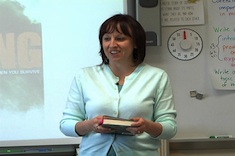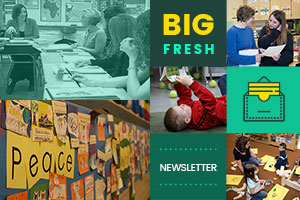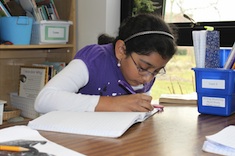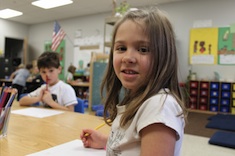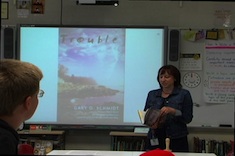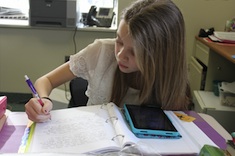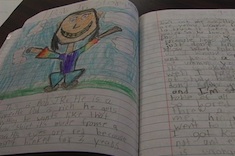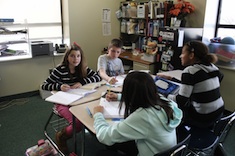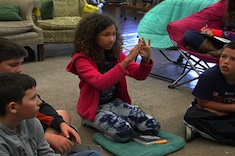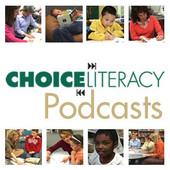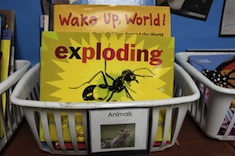Library
Choice Literacy Articles & Videos
The Choice Literacy library contains over 3,000 articles and 900 videos from 150+ contributors. Classic Classroom and Literacy Leadership subscribers have access to the entire library. Content is updated continuously, with five to six new features published each week.
Latest Content
The Living: Book Talk
Christy Rush-Levine introduces The Living to her eighth graders.
The Big Fresh July 9, 2016 A Fork in the Road
Teaching procedural writing is the focus of this week’s Big Fresh.
Laying the Foundation for Genre Writing
Shari Frost helps a teacher dealing with dreadful how-to drafts from her students by sharing quality mentor texts.
A Joyful Mess
Ruth Ayres writes about the messiness of analyzing needs, celebrating achievements, and thinking about what’s next with writers in workshops.
The Big Fresh June 25, 2016 Repurposed
Repurposing materials for literacy instruction is the focus of this week’s Big Fresh.
Old-Fashioned Resources
Jennifer Schwanke cleans out a school storage area, and with advice from teachers discovers new purposes for old items she was about to discard.
Fostering Thinking Through Play
Katie DiCesare repurposes materials for her first graders to play with, and finds that encouraging play early in the year is a great tool for building reflection skills.
Getting to Know Writers: The Writing Process Survey
Dana Murphy continues her series on getting to know writers early in the year. In this installment, she explains how to use a simple six-question survey to help teachers and students explore differences in writing routines and habits.
Book Talk: Trouble
Christy Rush-Levine previews the book Trouble by Gary D. Schmidt.
The Big Fresh June 18, 2016 What We Brew
Writing routines are the focus of this week’s Big Fresh.
Last Chance Workshop
Christy Rush-Levine breaks her routine of responding to student writing, and instead calls on students to guide and support peers. She shares some surprising results.
Conferring with Ben: Brainstorming Writing Topics and Genres
Katherine Sokolowski helps fifth grader Ben brainstorm ideas for writing, and in the process encourages him to try a new genre.
Getting to Know Writers: Introduction
Dana Murphy writes about the litmus tests we give writing teachers to analyze whether or not they are teaching the "right" way, when we might better serve students by focusing on the six truths of writing.
The Big Fresh June 11, 2016 New Tires
Creative possibilities for nonfiction is the focus of this week’s Big Fresh.
Nonfiction Research Group in Fifth Grade
Katherine Sokolowski meets with a group of fifth graders who are all researching the use of nets in fishing and the environmental effects of the process. She works to build connections among classmates as well as research skills.
Digging into Research Questions
Melanie Meehan explains how helping students deepen their questioning strategies leads to more thoughtful research projects.
The Big Fresh June 4, 2016 The Loudest Voices
Audiobooks are the focus of this week’s Big Fresh.
Making the Most of Small Groups with Jennifer Serravallo (PODCAST)
In this podcast, Jennifer Serravallo shares her “then” and “now” reflections about how guiding groups has evolved in her classroom.
Book Talk: When We Broke Up
Christy Rush-Levine piques the interest of her eighth graders in When We Broke Up by Daniel Handler.
Understanding Josh: The Audio Reader
Jennifer Schwanke tells the story of Josh, a special-needs student who is almost impossible to reach, until one committed teacher unlocks the key to what makes him tick as a learner.
Lester Laminack on Bullying (PODCAST)
In this podcast, Franki Sibberson chats with Lester Laminack about bullying. Lester is the author of beloved books for children and teachers including Saturdays and Teacakes and Unwrapping the Read Aloud
.
“Reinventing Language Every Time You Write” with Ralph Fletcher (PODCAST)
Ralph Fletcher recognizes that many teachers love language and explains how to bring that love of words to young writers.
Writing Models with Kelly Gallagher (PODCAST)
In this podcast, Kelly Gallagher reminds us of the power of the person right next to writers when they are learning the craft.
Putting the “Gradual” Back into Gradual Release of Responsibility
If it’s not sudden release of responsibility or no release of responsibility, what does gradual look like? Clare Landrigan and Tammy Mulligan bring this model to life.
New and Improved Nonfiction
Jennifer Schwanke remembers the days when mimeographed nonfiction pieces were rare and not welcome additions to elementary classrooms, and reflects on how much has changed.
#articleaday
Justin Stygles uses a daily nonfiction article activity as a way to build interest in nonfiction short texts, especially among reluctant readers in his classroom.
The Big Fresh May 28, 2016 Grin and Bear It
How to teach with Twitter is the focus of this week’s Big Fresh.
Tweets in the High School Classroom
Gretchen Schroeder finds that tweets are a terrific quick assessment tool for analyzing student understanding of everything from nonfiction texts to character development in classic literature.
Tweeting a Favorite Author
Katherine Sokolowski helps one of her fifth-grade students compose a tweet to a favorite author.
Browse Content By
Type
Category
- Assessment Tools
- Big Fresh Archives
- Booklists
- Choice Numeracy
- Classroom Design
- Common Core
- Community Building
- Conferring
- Content Literacy
- Digital Literacy
- English Language Learners
- Equity
- Family Relations
- Free Samples
- Guiding Groups
- Leadership
- Literacy Coaches
- Mentor Texts
- Minilessons
- New Teacher Mentors
- Podcasts
- Poetry
- Quote Collections
- Reading Strategies
- Self Care
- Struggling and Striving Learners
- Talking and Listening
- Teacher Study Groups
- Teaching Reading
- Teaching Writing
- Word Study and Vocabulary
Author
- Melissa Quimby
- Nawal Qarooni
- Gwen Blumberg
- Julie Cox
- The Lead Learners
- Hannah Tills
- Josie Stewart
- Ruth Metcalfe
- Mallory Messenger
- Becca Burk
- Jodie Bailey
- Vivian Chen
- Mary Brower
- Tiffany Abbott Fuller
- Stephanie Affinito
- Ruth Ayres
- Leigh Anne Eck
- Heather Fisher
- Shari Frost
- Julie Johnson
- Suzy Kaback
- Gigi McAllister
- Shirl McPhillips
- Melanie Meehan
- Cathy Mere
- Debbie Miller
- Tara Barnett and Kate Mills
- Tammy Mulligan
- Dana Murphy
- Bitsy Parks
- David Pittman
- Brenda Power
- Heather Rader
- Matt Renwick
- Mandy Robek
- Christy Rush-Levine
- Gretchen Schroeder
- Jen Schwanke
- Brian Sepe
- Katherine Sokolowski
- Stella Villalba
- Jennifer Vincent
Grade Level
Choice Literacy Membership
Articles
Get full access to all Choice Literacy article content
Videos
Get full access to all Choice Literacy video content
Courses
Access Choice Literacy course curriculum and training

